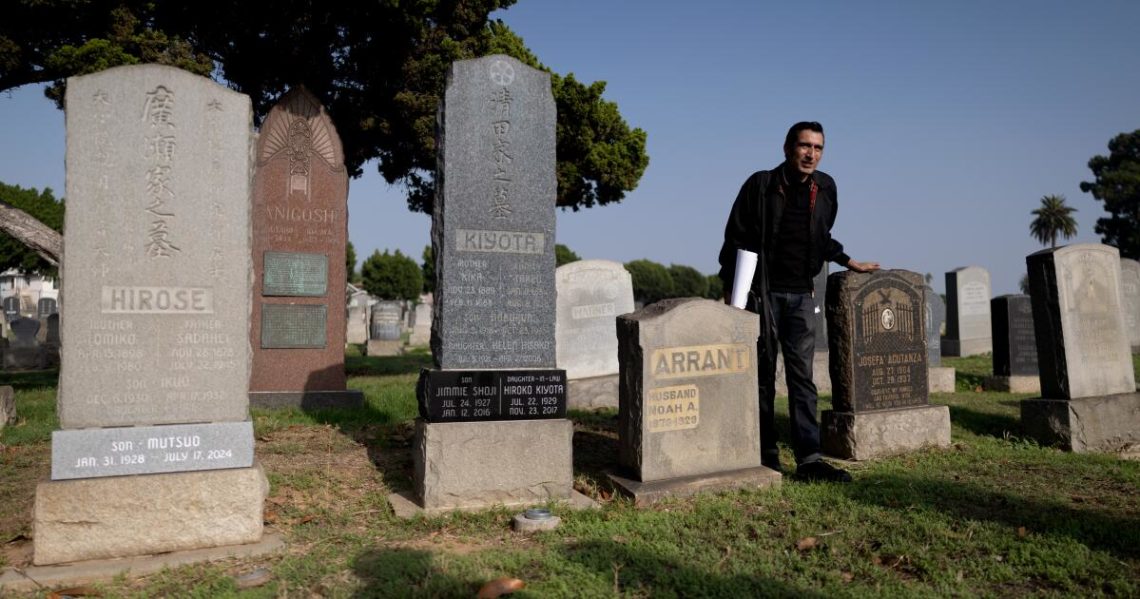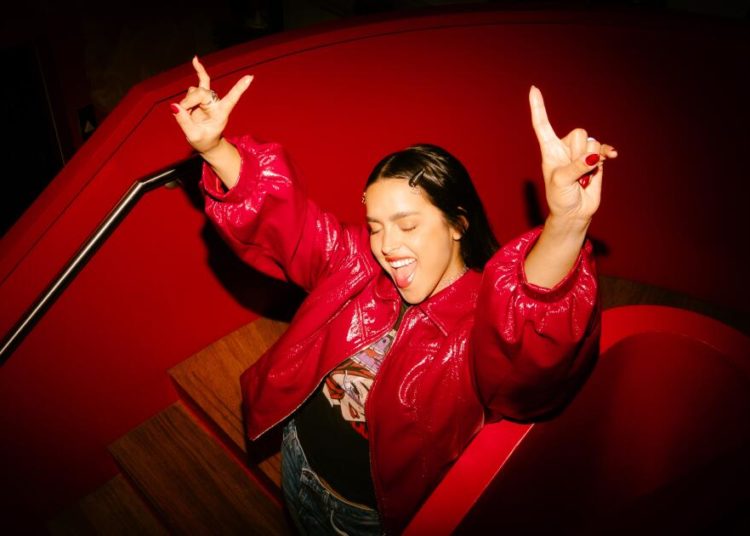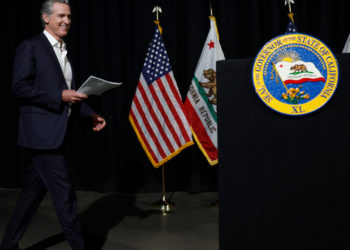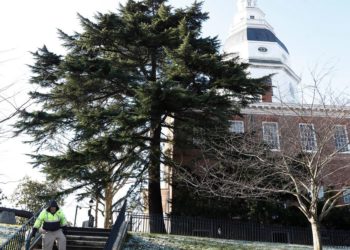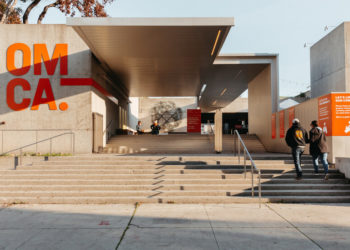A tour in Los Angeles usually entails riding around the city in an open-air vehicle, as a tour guide points out celebrity homes, scenic photo-ops and iconic movie locations.
But in Boyle Heights, local historian and tour guide Shmuel Gonzales takes a more personal approach. The community organizer, who goes by the name “Barrio Boychik,” tells the lesser-known stories of the historically multicultural neighborhood.
“We want our history told correctly, and for it to represent the stories of the working-class immigrants who live here. We needed someone from the community to be able to do it,” said Gonzales, who sat by the main gates of the Evergreen Cemetery, ready to begin his walking tour. “I had to step up.”
It was a cloudy Sunday morning, and the cemetery was uncharacteristically green, following L.A.’s recent spout of rain. A small group of 10 visitors gathered around Gonzales, eager to begin the history lesson. With slicked-back hair and a thick binder in hand, he kept an eye out for potential stragglers. Roughly a week before Día de los Muertos, Gonzales focused the tour on the significance of the Evergreen Cemetery in L.A. and its role in the city’s first-ever Día de los Muertos event.
With endless rows of moss-ridden, uneven headstones and towering post-mortem monuments, the Evergreen Cemetery isn’t hard to miss. Most Boyle Heights residents encounter it daily, as it’s bordered by several of the neighborhood’s main streets: Cesar Chavez Avenue, Lorena Street, Evergreen Avenue and 1st Street.
Founded in 1877, it’s both the first privately owned and non-segregated cemetery in Los Angeles, as well as the oldest. At the time, the developers thought its location was optimal, because the surrounding area wasn’t very populated and there was a belief that settlement wouldn’t go so far east. Today, it’s situated in the middle of the neighborhood between Los Cinco Puntos (of “Blood In Blood Out” fame) and El Mercado, the landmark shopping center for Mexican goods of all kinds. There’s also a popular jogging trail that circles the cemetery’s perimeter, where runners outpace each other and dog walkers exchange greetings.
Along the outskirts of cemetery grounds, there were a few patches of more recent graves, decorated with brightly colored marigolds. Several families gathered around in folding chairs and under shady canopies to spend time with deceased loved ones. Some headstones were adorned with Halloween decorations, while others embodied the Día De Los Muertos spirit with decorated calaveras and scattered marigold petals.
Gonzales points out all of the dispersed families throughout the ghastly field and said that Los Angeles has been publicly celebrating the holiday for over 50 years. It started out as a part of the Chicano Movement. Sister Karen Boccalero, the founder of community art center Self Help Graphics and Art, noticed morale in the neighborhood was low, given the number of deaths within the community from the Vietnam War.
“She was one of the few people who believed that the civil rights movement needed to move forward. She was a Franciscan nun who wouldn’t wear a habit and would chain smoke. She was the type of nun who got things done,” said Gonzales.
Boccalero had the idea to help invigorate the community by celebrating Dia de Los Muertos in the neighborhood. In 1973, she and other Chicano artists had organized a parade of handmade floats to honor those the community was mourning. The parade started at Evergreen Cemetery and continued down Cesar Chavez Avenue. Over half a century later, the tradition still continues at the art nonprofit. This year’s parade will take place on Nov 1.
“The holiday was uniquely revived in an American, Mexican and Chicano perspective for a purpose. So here in our community, it’s forever intertwined with all of those you know, men and women who gave their lives in an unjust war,” said Gonzales.
Walking through the cemetery, Gonzales stops by the graves of some of the city’s earliest developers — many of whom areas and streets are named after, like the Lankershims, the Van Nuys, the Hollenbecks and the Bigsbys. Beyond the more recognizable names, he pays homage to all the different groups of people buried there and explains in detail how they ended up in Evergreen — such as the displaced Chinese cemetery and the memorial to the Japanese American World War II veterans.
Despite his ability to speak for upwards of four hours, Gonzales didn’t set out with the dream of being a local tour guide. It’s something that came to him naturally.
“By being a local within the community and hanging around on the weekends, people would come by start asking questions like, ‘Why is this here?’ or ‘What is this building?’” said Gonzales, who knew the answers based on his own research and various oral traditions passed down from his family. “People started to figure out that I would be by the Sixth Street bridge in the evening… They would regularly come by and want me to tell them about something.”
Gonzales can trace his family roots in Los Angeles, specifically East L.A., back by six generations. They first emigrated from Mexico in the 1830s and settled in the area. Raised mostly by his grandparents, a lot of his childhood memories are connected to stories he wasn’t supposed to hear. Often, he was one of the only kids who was able to listen, as he said his ADHD required him to be supervised closely and his family couldn’t send him outside to play with the others. He also had the advantage of being able to speak Spanish, so he understood the tales entirely.
“Once you become an adult and you get into academia with history, you’re mostly trying to debunk the history you’ve already been taught. Over the years, the stories have been simplified and littered with urban legends and prejudices of the time,” said Gonzales, who describes the stories as “cuentas exacerbados.” “As I was researching them, I realized that they just had scratched the surface in the storytelling. There’s actually more than a kernel of truth in there.”
Around a decade ago, he said he noticed gentrification starting to creep in and that he needed to take his calling more seriously, so he began giving formalized tours. Today, he hosts over 20 variations of tours around East L.A., featuring anything from the most haunted spots in Boyle Heights to retracing the landmarks of the once-vibrant Jewish community in the neighborhood.
With the revenue from ticket sales, he also founded the Boyle Heights History Studios, a community cultural center, in 2018. After COVID-19, he had to give up his physical museum space and now focuses on cultivating community online and through pop-up events.
“There are so many things that we’ve learned in school, but none of it is the stuff that Shmuel shares. It’s all such new information,” said Susana Betancourt, a retired teacher and Boyle Heights resident who has been coming to Gonzales’ tours for around five years. “I always try to invite new people to come and learn. It’s important that more of us learn this information so that we, too, can continue to pass it all down.”
Drawing from over two centuries of family knowledge, Gonzales said that sharing his blend of family stories and untold histories is a way to fight for the preservation of L.A.’s history, like the Evergreen Cemetery.
“We have to keep telling these stories so that the ancestors live through us,” said Gonzales. “But also so that we can hopefully keep this cemetery going on for another century and a half.”
The post Inside Evergreen Cemetery with Boyle Heights’ resident historian, the Barrio Boychik appeared first on Los Angeles Times.
